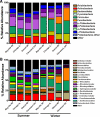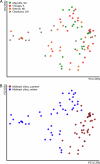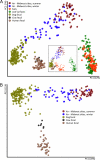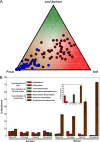Sources of bacteria in outdoor air across cities in the midwestern United States
- PMID: 21803902
- PMCID: PMC3187178
- DOI: 10.1128/AEM.05498-11
Sources of bacteria in outdoor air across cities in the midwestern United States
Abstract
Bacteria are abundant in the atmosphere, where they often represent a major portion of the organic aerosols. Potential pathogens of plants and livestock are commonly dispersed through the atmosphere, and airborne bacteria can have important effects on human health as pathogens or triggers of allergic asthma and seasonal allergies. Despite their importance, the diversity and biogeography of airborne microorganisms remain poorly understood. We used high-throughput pyrosequencing to analyze bacterial communities present in the aerosol fraction containing fine particulate matter of ≤2.5 μm from 96 near-surface atmospheric samples collected from cities throughout the midwestern United States and found that the communities are surprisingly diverse and strongly affected by the season. We also directly compared the airborne communities to those found in hundreds of samples representing potential source environments. We show that, in addition to the more predictable sources (soils and leaf surfaces), fecal material, most likely dog feces, often represents an unexpected source of bacteria in the atmosphere at more urbanized locations during the winter. Airborne bacteria are clearly an important, but understudied, component of air quality that needs to be better integrated into efforts to measure and model pollutants in the atmosphere.
Figures





References
-
- Albrecht A., Witzenberger R., Bernzen U., Jackel U. 2007. Detection of airborne microbes in a composting facility by cultivation based and cultivation-independent methods. Ann. Agric. Environ. Med. 14:81–85 - PubMed
-
- American Lung Association 2007. Trends in asthma morbidity and mortality. American Lung Association Epidemiology and Statistics Unit, Research and Program Services Division, Washington, DC: http://www.lungusa.org/finding-cures/our-research/trend-reports/asthma-t...
-
- American Veterinary Medical Association 1997. U.S. pet ownership & demographics sourcebook. American Veterinary Medical Association, Schaumburg, IL
-
- Bibby K., Viau E., Peccia J. 2010. Pyrosequencing of the 16S rRNA gene to reveal bacterial pathogen diversity in biosolids. Water Res. 44:4252–4260 - PubMed
Publication types
MeSH terms
Grants and funding
LinkOut - more resources
Full Text Sources

